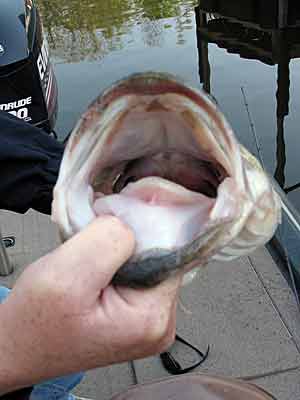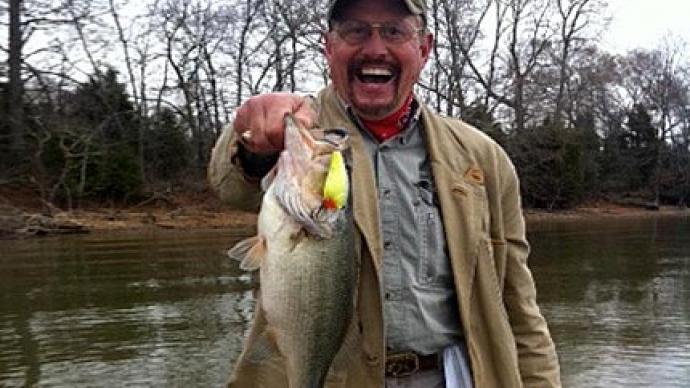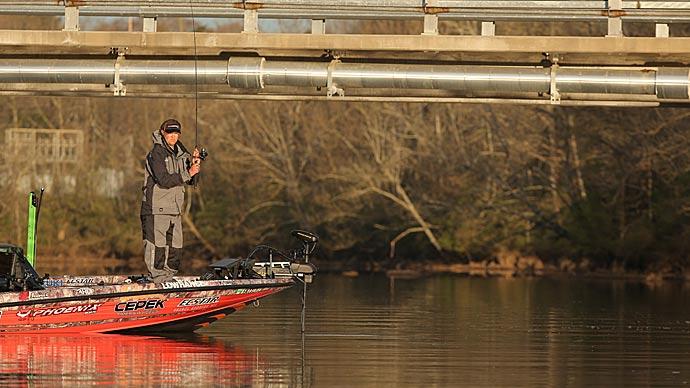
Ah summer. It's almost that time again. When the warmer weather moves bass to deeper water during "dog days" you don't have to dread its arrival. But if you do, you're probably not too fond of deep-diving crankbaits or dragging around any slow-crawling worms either.
While many anglers will avoid deep-diving cranks and worms because they get tired of pulling up half the junk on the bottom of the lake or weariness from cranking all day, others thrive on the season. But from grass to trotlines and everything else that's on the bottom of our lakes, fishing that deep just seems to locate all the things that you aren't looking for. And let's face it... it's a lot more tiring to crank cranks all day, especially deep-divers. You can go home beat and that sometimes takes a little of the fun out of fishing.
Then there's always the bait loss factor. How many baits you lose in a day's fishing can be expensive, especially in the beginning. If you lose a dozen crankbaits in a single fishing trip, it's possible that someone is going to want to know how much more you intend to spend on such a worthless item. But you can take heart, there's hope for you yet. And you have to know that you can't fish shallow water forever.
The most important thing to do first of all is use the proper equipment for the task. Sometimes anglers fail to realize that their favorite rod isn't the right one for every fishing application. Use at least a 7-footer for deep cranking and make sure it's one with a trigger-type handle. Rods with trigger-type handles are useful for this application because you can lay the butt of the rod against your hip. This takes a lot of the pressure off your wrists. And after a full day of cranking, you will know what wrist pain is I promise!
These two factors can have more influence over a change of heart than anything else you will do. Make sure the rod has plenty of strength with a medium to medium-heavy tip at the very least. Even though you are fishing deep, what you feel on the end of your line will make a difference in your catch ratio.
If a 7-foot rod is harder for you to use than a 6-foot 5-incher or shorter then use the shorter rod, but know that the length of the rod will make a difference - even if slight - in how far you can cast your lure. But comfortable casting means you can cast more so by all means don't fish the 7-footer if it's uncomfortable for you. You'll just get too tired to use it well anyway.
The next important step is to select a reel that has a smooth drag system, one that you can put a lot of line on and that will allow you to cast as far as possible. And check the gear ratio on your favorite reels to make sure you're getting the most "bang" for your cast. Reels with a low gear ratio won't get you there without working you to death. Use a reel you're comfortable with. When you're trying to reach depths of 20 to 25 feet or deeper, it takes a lot of distance on your cast to have the bait get down to the desired depth and still manage to be in the strike zone. Comfort with your rods and reels is important, regardless of what bait you're fishing, but it can be critical with deep cranks simply because of the amount of effort required to fish them.
Keep in mind too that fishing deep cranks isn't something you only do in deep water. They can be fished to great advantage in shallow water. Using a deep-diving crankbait to dredge up mud makes a real "action" show for bass in the area that may be watching. Cranks can also work well fished along flats in 10 or 15 feet of water, the mid-depth ranges. Creek channels, even shallower ones, are prime areas where fishing a deep-diving crank with a large lip will definitely attract some larger bass. If the water is off-colored, try using heavier line. Line size can be the key to using these baits at different depths. As well, the size of the lip on the crank can make a big difference in the action and depths the baits reach.
If you're fishing a point in 18 to 22 feet of water, try using 10- or 12-pound test line and a crankbait with the largest lip you can find. When fishing this deep, use at least 7-1/2-foot rod. The reason for this is so that you can put your rod tip down into the water as far as you can reach and crank the bait. This will add depth to the bait as it is retrieved.
If you want to see how this works, take a crankbait that runs about 15 feet deep. With your depth finder, locate a clean, tapered point. Drop a marker at 14 feet and then another at 18. Now use the same retrieve and hold your rod straight out in front of you. As you move out where the crankbait doesn't bump the bottom, remember that spot, or drop another marker there. On your next cast, throw out to the deeper side of the marker and run your rod down in the water about three feet. You'll be able to see the results on your depth finder. This little bit of extra work can put more fish in your boat. You can, by simply running your rod tip down into the water, control how much more the bait will dive and that can have a profound effect on your end results.
When fishing deep cranks, run your rod down near the surface of the water. As you start the bait down, reel at a fairly rapid pace. Remember that as your speed of retrieve increases, so does the volume of water forced across the lip of your lure. If the volume of water becomes greater than the displacement the lip can handle, the bait will actually rise instead of dive. You will be able to feel this when the bait starts feeling like it's losing some of its "weight." When you feel the pull lessening, slow your retrieve, you are probably reeling too fast. Cranks are meant to be retrieved quickly, but not that fast.
Depending on weather and other conditions, bass may want a bait that's moving fairly fast or sometimes they only hit a bait that is retrieved using a stop-and-go erratic type of retrieve. Once you get the bait down to the desired depth for the conditions, just try several types of retrieves several times until you can tell which way they will hit it.
And keep in mind that if you're not banging into a lot of things with these baits, you're not fishing them right. Of course you can get hung up bumping into underwater objects, but it doesn't look natural for baitfish to swim openly in areas where there are stumps and laydowns. Watch baitfish as they swim. They shift here and there, moving in and around objects. They don't swim straight as an arrow across open water. A crankbait bumping into things looks more natural to bass, especially if it looks scared or wounded - or better yet both.
This type of fishing generally requires heavier line than 10- or 12-pound test. Crankbaits, fished properly, crashing into rocks, brush, and stumps can really fray your line fast. So retie often and when you do, strip off several feet of line each time. You can pull your line between your thumb and forefinger lightly and feel the nicks and cuts in it after repeated casts to "prickly" things. You will need to do this many times in a day of crankbait fishing.
Choosing where to fish deep-diving cranks is extremely important. Understanding bass movement and patterns will help you know why this is the case. Many factors come into play on just how far bass will travel. If they have what they need in a fairly small area, they won't move much if at all. Water depth, forage, cover, and quality spawning places are just a few of the elements involved in their daily habits depending on the time of year. When conditions are right, some bass will remain in fairly small areas, if things aren't as they need them to be they may travel several miles, or more, to find optimum conditions.
Some areas in most of our lakes will hold fish year round if there are creeks nearby. If the creek, or drop, is really deep, use the deepest running crank you have or switch to a jigging spoon if need be. Turn on your electronics and fish back and forth across the creek. As you move up the creek, look for both baitfish and bass activity. A secondary point coming toward you should be fished at length, not run-and-gun fashion. If there are baitfish present, concentrate your efforts on structure that intersect in the area.
As the water warms and summer arrives in full force, some bass will move to areas where there are gentle slopes. Tapered points, humps, and ridges, as well as roadbeds, tank dams, and creek channels will all hold fish. During extremely hot months, main-lake points and humps will be the best place to catch fish. Fish these areas from all angles. Bass will position themselves for their best chance to catch a meal and finding that exact position can be critical.
The best summer colors are usually shad or chartreuse, depending on water clarity. But if you aren't getting bites, it's time to change color and bait. Don't get into a rut and throw the same bait, in the same color, in the same water all the time. Change is good for experimenting to find out what the bass want and for catching them.
And if you want to learn to be more adept at keeping your crankbaits, rather than losing them to structure, get yourself a lure retriever. And remember if you do get hung up, don't pull hard trying to get your lure loose. Go to the side of the bait that should be behind where you cast it and thump your line between your fingers. Many anglers have perfected the art of "plucking" their line to loosen baits. It's really fairly easy and works well even for other baits than just crankbaits.
Usually areas where you located fish in the spring will also hold fish in the fall. Creek channels can be even better in the fall because the lake is likely to be lower following summer heat than it was in the spring with spring rains coming in. Fish the mouths of the creeks to about half way back, watching for baitfish as you move from spot to spot. Bass will be following the baitfish. Once you catch a fish, slow down and fish the area thoroughly because there will be more fish in the area.
Learning to use crankbaits to your advantage is important. Even if you hate them, use them anyway. Very often, especially in the summer heat, they can really save the day if you don't want to go home fishless. They are tiring, can be expensive, and you may want to cuss a blue streak because you get hung up so often, but they will catch bass.




